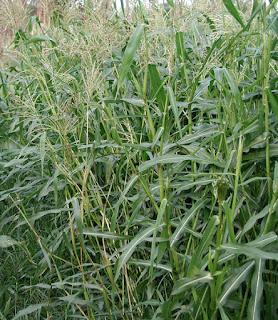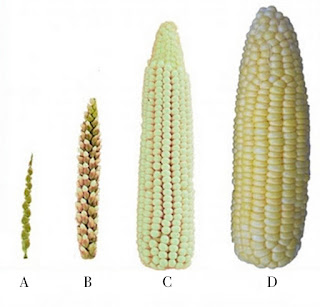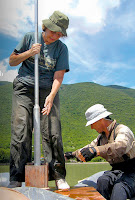As has been shown, the progenitor to maize (corn) was the teosinte plant, which is the common name for a group of four annual and perennial species of the genus Zea native, and are taller and broader-leaved than most grasses.
The teosinte plant, one of the many grain plants, of which all grains
are the seeds of grasses
from the biological family Poaceae,
relatives of the Kentucky bluegrass or rye grass that grow in most back yards
However, he has pinpointed one form of teosinte, known as Z. mays ssp. parviglumis, shares a particularly close genetic relationship with maize and available evidence indicates that it is the direct ancestor of maize .
Yoshihiro Matsuoka has pointed out that “There exists extraordinary morphological and genetic diversity among the maize landraces that have been developed by pre-Columbian cultivators” (“A Single Domestication for Maize,” Proceedings of the National Academy of Sciences, 2002. pp6080-6084), suggesting that all maize arose from a single domestication, originating during a brief period in human history, and that “maize has been considered to be the product of multiple independent domestications from its wild progenitor (teosinte) because of the remarkable morphological and genetic diversity that exists within it.”
Left: the wild-type maize plant in which the gene called grassy tillers
1 is mutated—arrows point to lateral branches called tillers, which are
suppressed in the wild type
It is believed that ancient farmers in the Americas took the first steps in domesticating maize when they simply chose which kernels (seeds) from the wild grass plants they would plant. Obviously, not all plants were the same—some may have grown larger than others, or maybe some kernels tasted better or were easier to grind, or were softer. Likely, the farmers saved kernels from plants with desirable characteristics and planted them for the next season's harvest—in a process today called selective breeding or artificial selection. Through this process, the cobs became larger, with more rows of kernels, eventually taking on the form of early maize cobs, where even the oldest archaeological samples bear an unmistakable resemblance to modern maize. It would have been obviously noted by these early farmers that the small changes had dramatic effect.
It is also of note that what we think of as natural corn today is quite different than the natural corn growing non-engineered crops, and the sweet corn we almost exclusively eat today was not even developed until the 1700s.
Developed corn through genetically
modified or engineered processes. A=Natural Teosinte; B=Hybrid of teosinte and
maize; C=Today’s hybrid maize; D=Genetically modified sweet corn
As William Tracy, Dean of the College of Agricultural and Life Sciences, University of Wisconsin-Madison, pointed out at the Organic Seed Growers Conference in Port Townsend, Washington, “plant breeding is not a science but a technology…Plant breeding is working with plants—the breeder selects, and the plant creates solutions.”
In the case of maize, the unimpressive grass plant called teosinte was improved upon genetically through trial and error to become a prime source of food for the human family.
It might be of interest to know that, according to Dolores Piperno (left), of the Smithsonian Tropical Research Institute (Journal of Archaeological Science, 30, 2003, pp831-836), who has devoted her life to the study of wild and domesticated grasses, claims the work of John E. Staller and Robert G. Thompson, who say the research showing maize development in northwestern South America being without merit, was inaccurate and misquoted and misstated the research she had accomplished, especially in Ecuador.
It might also be of interest to know, that despite claims that maize (corn) domestication took place in Mexico, as more and more studies are being conducted in Andean South America, it is now understood from new techniques to recover starch granules from charred cooking-pot residues in the Andes, it is now known that maize was present, cultivated, and consumed there several thousand years earlier than previously believed. In fact, dating the residues by accelerator mass spectrometry (AMS) radiocarbon measurement, the results represent the earliest direct dates for maize in Early Formative Ecuadorian sites and provide further support that, once domesticated, maize spread rapidly from southwestern Mexico to northwestern South America (Zarrillo, Pearsall, Raymond, Tisdale, and Quon, “Directly dated starch residues document early formative maize in tropical Ecuador,” Proceedings of the National Academy of Sciences, Vol 105, No 13, pp500-5011)
In fact, according to Dolores Piperno, “in the 1950s village sites were discovered in southwestern Ecuador that predated by at least 1000 years the first sedentary villages in Mexico and Peru, the heartlands of later civilizations. Much debate has centered on the subsistence base of the Early Formative cultures of coastal Ecuador and whether maize was grown and consumed as a food item” (Smithsonian Institution, Washington, DC, and Balboa, Panama, February 1, 2008).
Southwestern coastal Ecuador showing the location of sites mentioned in
the Zarrillo study. Loma Alta and Real Alto are ceramic-bearing Formative
Period Valdivia sites, whereas the Las Vegas site is preceramic









No comments:
Post a Comment